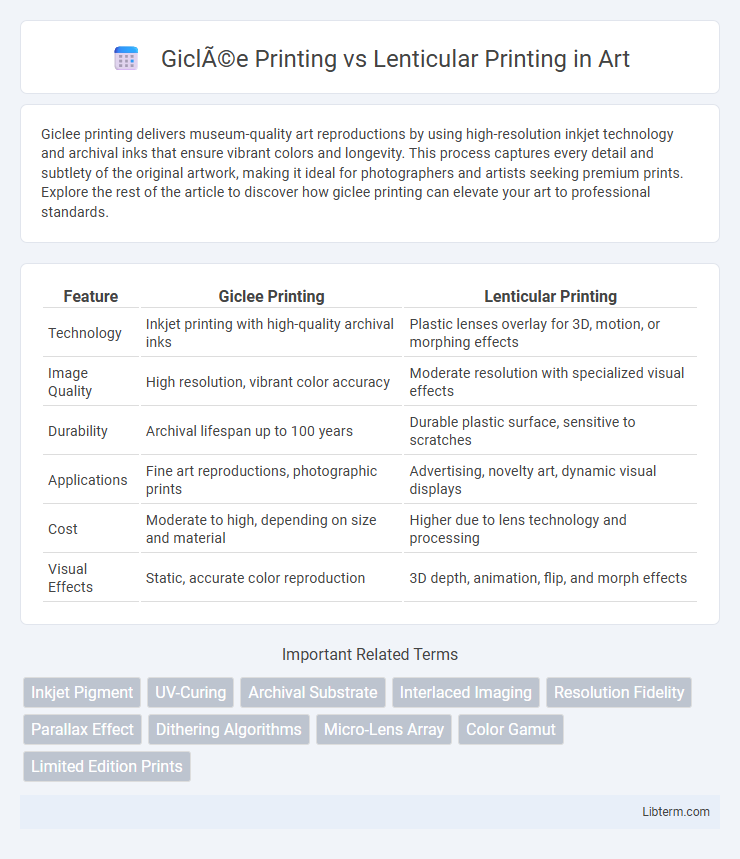Giclee printing delivers museum-quality art reproductions by using high-resolution inkjet technology and archival inks that ensure vibrant colors and longevity. This process captures every detail and subtlety of the original artwork, making it ideal for photographers and artists seeking premium prints. Explore the rest of the article to discover how giclee printing can elevate your art to professional standards.
Table of Comparison
| Feature | Giclee Printing | Lenticular Printing |
|---|---|---|
| Technology | Inkjet printing with high-quality archival inks | Plastic lenses overlay for 3D, motion, or morphing effects |
| Image Quality | High resolution, vibrant color accuracy | Moderate resolution with specialized visual effects |
| Durability | Archival lifespan up to 100 years | Durable plastic surface, sensitive to scratches |
| Applications | Fine art reproductions, photographic prints | Advertising, novelty art, dynamic visual displays |
| Cost | Moderate to high, depending on size and material | Higher due to lens technology and processing |
| Visual Effects | Static, accurate color reproduction | 3D depth, animation, flip, and morph effects |
Introduction to Giclée and Lenticular Printing
Giclee printing utilizes high-resolution inkjet technology to produce museum-quality fine art prints with vibrant colors and detailed gradations, making it ideal for reproducing photographs and artwork on archival paper or canvas. Lenticular printing creates images with an illusion of depth or motion by overlaying multiple images with a lenticular lens, commonly used for 3D effects, animations, and eye-catching marketing materials. Both techniques serve distinct purposes: Giclee excels in precise color fidelity and longevity, while lenticular focuses on dynamic visual effects.
What is Giclée Printing?
Giclee printing is a high-quality inkjet printing process that produces detailed and vibrant art reproductions using archival-quality pigment-based inks on fine art paper or canvas. This method ensures exceptional color accuracy, longevity, and resolution, making it ideal for photographers, artists, and galleries seeking museum-quality prints. Giclee prints offer superior durability compared to traditional inkjet prints, maintaining their brilliance for decades without fading.
What is Lenticular Printing?
Lenticular printing is a technique that creates images with an illusion of depth, motion, or morphing effects by using lenticular lenses to refract light. This method involves printing interlaced images beneath a lenticular sheet, allowing viewers to see different visuals at various angles. It is commonly used for eye-catching advertising, 3D displays, and novelty items, contrasting with Giclee printing's focus on high-resolution art reproductions on fine art paper.
Key Differences Between Giclée and Lenticular Printing
Giclee printing uses high-resolution inkjet technology to produce detailed, vibrant, and archival-quality art prints ideal for fine art reproductions, while lenticular printing employs a specialized lenticular lens to create images with depth, motion, or changing effects. Giclee prints emphasize color accuracy and longevity using pigment-based inks on fine art papers or canvases, whereas lenticular prints focus on visual interaction and three-dimensional illusions suited for promotional materials and novelty items. The main distinction lies in giclee's static, museum-quality output compared to lenticular's dynamic, multidimensional visual experiences.
Print Quality and Image Resolution
Giclee printing delivers superior print quality with ultra-high resolution, producing finely detailed images using archival-quality inks on textured papers or canvas, ideal for art reproductions. Lenticular printing offers unique visual effects such as depth, motion, or image transitions but typically has lower image resolution due to the lenticular lens overlay that can soften details. For sharpness and vibrant color accuracy, giclee printing remains the favored choice, whereas lenticular printing prioritizes dynamic visual impact over absolute resolution.
Applications and Uses
Giclee printing excels in high-quality art reproductions, fine art prints, and photography, providing exceptional color accuracy and detail for galleries, museums, and professional artists. Lenticular printing is primarily used for 3D effects, animations, and motion visuals on promotional materials, packaging, and advertising displays that require eye-catching, interactive effects. The choice between Giclee and lenticular printing depends on whether the application prioritizes static, ultra-high-resolution imagery or dynamic, visually engaging motion effects.
Durability and Longevity Comparison
Giclee printing uses archival inks and high-quality paper or canvas, providing exceptional durability with resistance to fading and environmental damage, often lasting 75-100 years or more under ideal conditions. Lenticular printing involves layering lenses over an image to create motion or depth effects, but the plastic lens surface is more prone to scratches and yellowing over time, potentially reducing longevity compared to giclee prints. Both methods require proper care, yet giclee prints generally offer superior archival stability and color retention for long-term display.
Cost Analysis: Giclée vs Lenticular
Giclee printing typically involves lower setup costs and uses high-quality inkjet technology, making it more cost-effective for small to medium print runs. Lenticular printing requires expensive specialized equipment and materials, resulting in higher initial costs but may offer better value for large volumes due to its unique 3D and motion effects. When comparing cost analysis, Giclee is ideal for fine art prints with detailed color reproduction, while lenticular's premium price supports dynamic visual impact and commercial applications.
Choosing the Right Printing Technique
Giclee printing delivers high-resolution, museum-quality art reproductions with vibrant colors and fine detail, making it ideal for photographic prints and artwork requiring color accuracy and longevity. Lenticular printing uses lenticular lenses to create dynamic images with depth, motion, or changing visuals, perfect for marketing materials or interactive displays demanding visual effects. Selecting the right printing technique depends on the project's goal--choose giclee for fine art reproduction and color fidelity, while lenticular suits applications needing eye-catching motion or 3D illusions.
Conclusion: Which Printing Method Is Best?
Giclee printing excels in detailed color accuracy and durability, making it ideal for fine art reproductions and photographic prints. Lenticular printing offers dynamic visual effects and motion illusions, perfect for advertising and packaging where engaging viewer interaction is key. Choosing the best method depends on whether precision and longevity or eye-catching motion and depth are the primary goals for the project.
Giclée Printing Infographic

 libterm.com
libterm.com